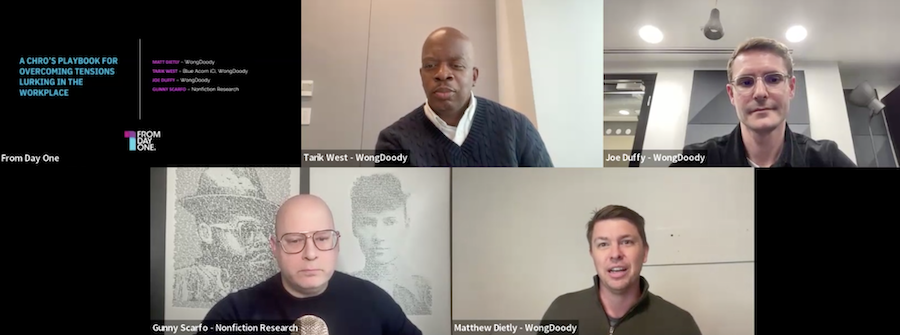A CHRO’s Playbook for Overcoming Tensions Lurking in the Workplace


An employee cries in the car on the way home, overwhelmed by the fear of losing their job. Another worries about bringing workplace stress into family life. Across organizations, HR professionals and managers are noticing a clear drop in morale—one that is taking a tangible toll on their teams.
“Employees and employers alike are disengaging, retreating into what researchers call Cold Work, a culture of quiet tension, mistrust and emotional fatigue,” said Steve Koepp, co-founder of From Day One and moderator of a webinar titled, “A CHRO’s Playbook for Overcoming Tensions Lurking in the Workplace.”
There are many issues that are tied up in the trend, among them conflicts between flexibility and accountability, complications from the Covid lockdowns as workers return to the office, and concerns about the use of artificial intelligence. But the overarching themes are distrust and alienation.
As Matt Dietly, employee experience lead at WongDoody, describes it, subtle, hidden tensions are driving managers and employees apart. They rarely break out into open confrontation, but “it feels like employees and employers are freezing each other out, clinging to survival, sort of waiting for the other side to blink, and it’s giving us so many Cold War vibes that we’ve christened the moment Cold Work,” he said.
Employers and employees have always had conflicting interests, Gunny Scarfo, co-founder of Nonfiction Research, observes. Those conflicts have emerged in many different ways: unionization in the early 20th century, stagflation and wages in the 1970s, and outsourcing 20 to 30 years ago. But this time the conflict is less connected to a specific grievance. It’s more general: “they don’t care, so I don’t care,” Scarfo said.

This mindset is pretty widespread: a Nonfiction Research poll of workers and managers shows that 44% agree that “both are more focused on trying to survive individually than trying to aspire,” said Scarfo.
Cold Work manifests itself in many ways. From the financial tech employee who says, ‘I’ve hardly spoken with my boss in the last year,’ to the manager who told his team ‘good news, no layoffs this year’ only to cut staff later on. But they all speak to the absence of camaraderie between managers and employees. In many instances, work has become transactional, we’re not necessarily on the same team anymore.
Root Causes and Presenting Issues
In this atmosphere of mutual distrust, there are a few presenting issues, the speakers shared. From frequent changes in technology and tools to ongoing debates over where work gets done, the workplace is experiencing heightened stress, uncertainty, and a growing disconnect between employees and management.
Companies can mandate a return to the office, but if they do “the workplace must deliver value, and that office experience must be seamless, so the return to work should be intuitive, frictionless, motivating. And that’s the responsibility of the employer,” said Joe Duffy, senior business development manager, EMEA at WongDoody.
Further, there is a tension between flexibility and accountability. Workers want the freedom to work in a way that makes sense for them, while employers prefer predictability and consistency, says Duffy.
But micromanagement leads workers to believe that they are not valued or trusted. Employers often “tend to think of a request for flexibility as some sort of directive to do less work, to be less productive,” said Tarik West, SVP of people at Blue Acorn iCi.
An End to Cold Work
Rigid, inflexible work drains productivity and eats into profits. Focus groups and anonymous feedback systems can help pinpoint problem areas. It’s worth exploring creative ways to balance flexibility with accountability—they don’t have to be at odds. Even small gestures, like allowing an afternoon off during the week in exchange for making up time at home over the weekend, can build goodwill.
But attitude is more important than any particular program. The key is to restore trust and confidence, and the only way to do that is with transparency. Dealing with things head-on is best over the long run, even if nothing can be done to address a worker's objections. “There will always be fixed points in the business, things that we can’t do, and you can’t be afraid to share bad news,” said West.
After all, the issue is really trust above all else, and the best way to regain it is to be honest and open. With frank communication and a little flexibility distrust should abate, putting workers and managers back on the same side.
Editor’s note: From Day One thanks our partner, WongDoody, for sponsoring this webinar.
Paul Kersey is a former attorney and freelance writer based in Chicago, IL.
(Photo by Prostock-Studio/iStock)
The From Day One Newsletter is a monthly roundup of articles, features, and editorials on innovative ways for companies to forge stronger relationships with their employees, customers, and communities.